Appearance
Decks, porches, stairs
Bottom line
Wood decks, porches, covered patios, and stairs are vulnerable areas that can spread flames to an attached structure. Reducing combustible items, screening with 1/8 inch metal mesh, and modifying the interface with the structure are important.
Overview
- Two types of exposure:
- Ember
- Deck material is important; also items stored on the deck
- Ignitions occur in the gaps between deck boards, which burns as a small fire for a long time as the fire propagates. Once the fire reaches the house, the fire can become larger if combustible siding was used.
- Flame impingement (from underside)
- Rely on defensible space and noncombustible ground cover
- Ember
- Zone classification
- If attached/proximally close to the home, we need to consider it part of the structure
- Immediate zone (0-5ft) would start from the perimeter of the deck
Material
Softwood
Decks made of softwoods like redwood and cedar are most common and also most vulnerable to ember exposures. Softwoods are less dense than hardwoods and easier to ignite with relatively shorter exposure time to embers.
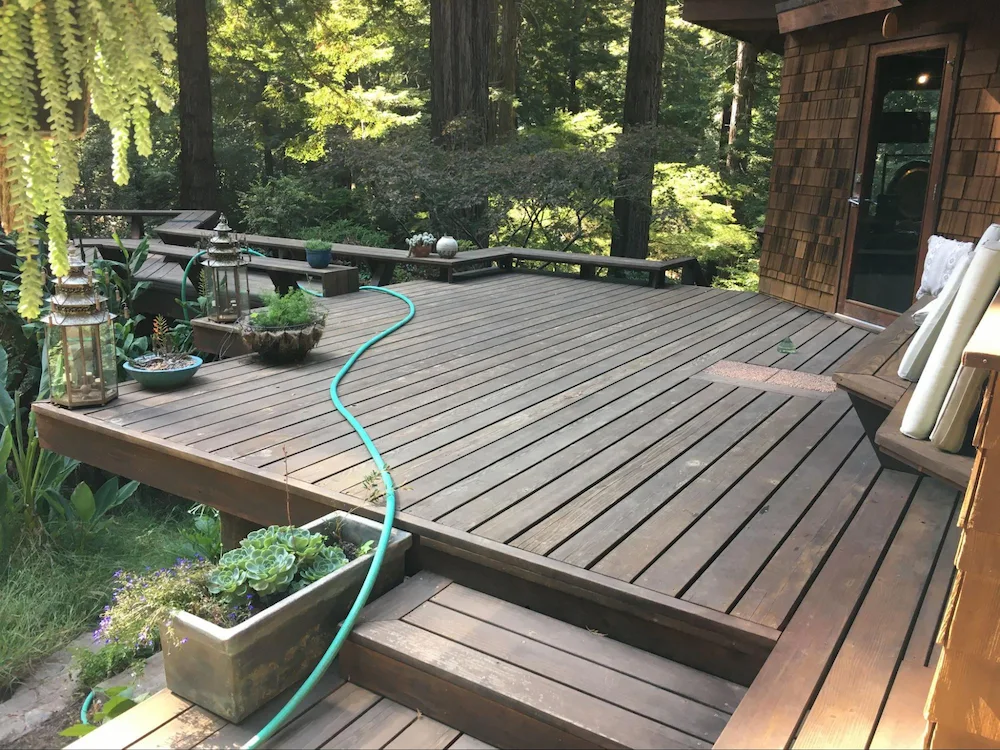 Softwood deck attached to structure with varying clearance to the ground due to hillside topology; this is a challenging scenario to mitigate due to deck’s size and its attached structure’s geometry.
Softwood deck attached to structure with varying clearance to the ground due to hillside topology; this is a challenging scenario to mitigate due to deck’s size and its attached structure’s geometry.
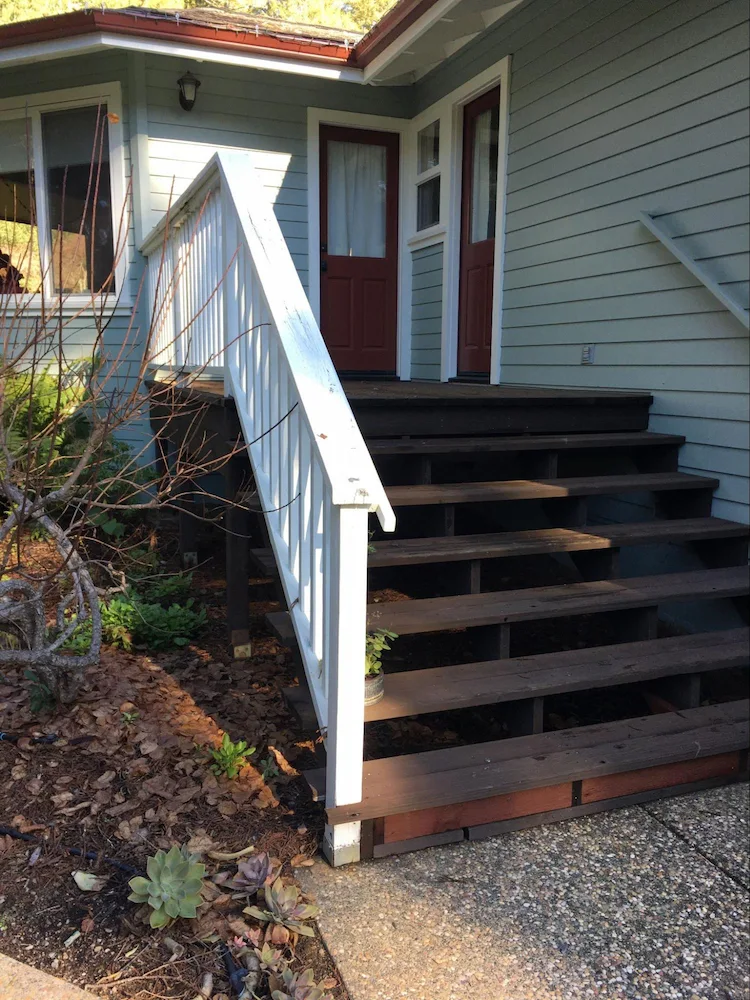 Softwood stairs and side deck. Exterior stairs share similar wildfire vulnerabilities and mitigations as decks. Note the lowest step has been retrofitted with multiple combustible wood boards to create a vertical fascia, which creates an ember ignition vulnerability similar to that addressed in the siding clearance section; better to remove the softwood fascia in this case.
Softwood stairs and side deck. Exterior stairs share similar wildfire vulnerabilities and mitigations as decks. Note the lowest step has been retrofitted with multiple combustible wood boards to create a vertical fascia, which creates an ember ignition vulnerability similar to that addressed in the siding clearance section; better to remove the softwood fascia in this case.
Hardwood
Hardwoods typically come from deciduous tree species and the most popular species for decking in California is Ipe wood. They are denser than softwoods and more resistant to ignition from ember exposures, but they are nonetheless combustible.
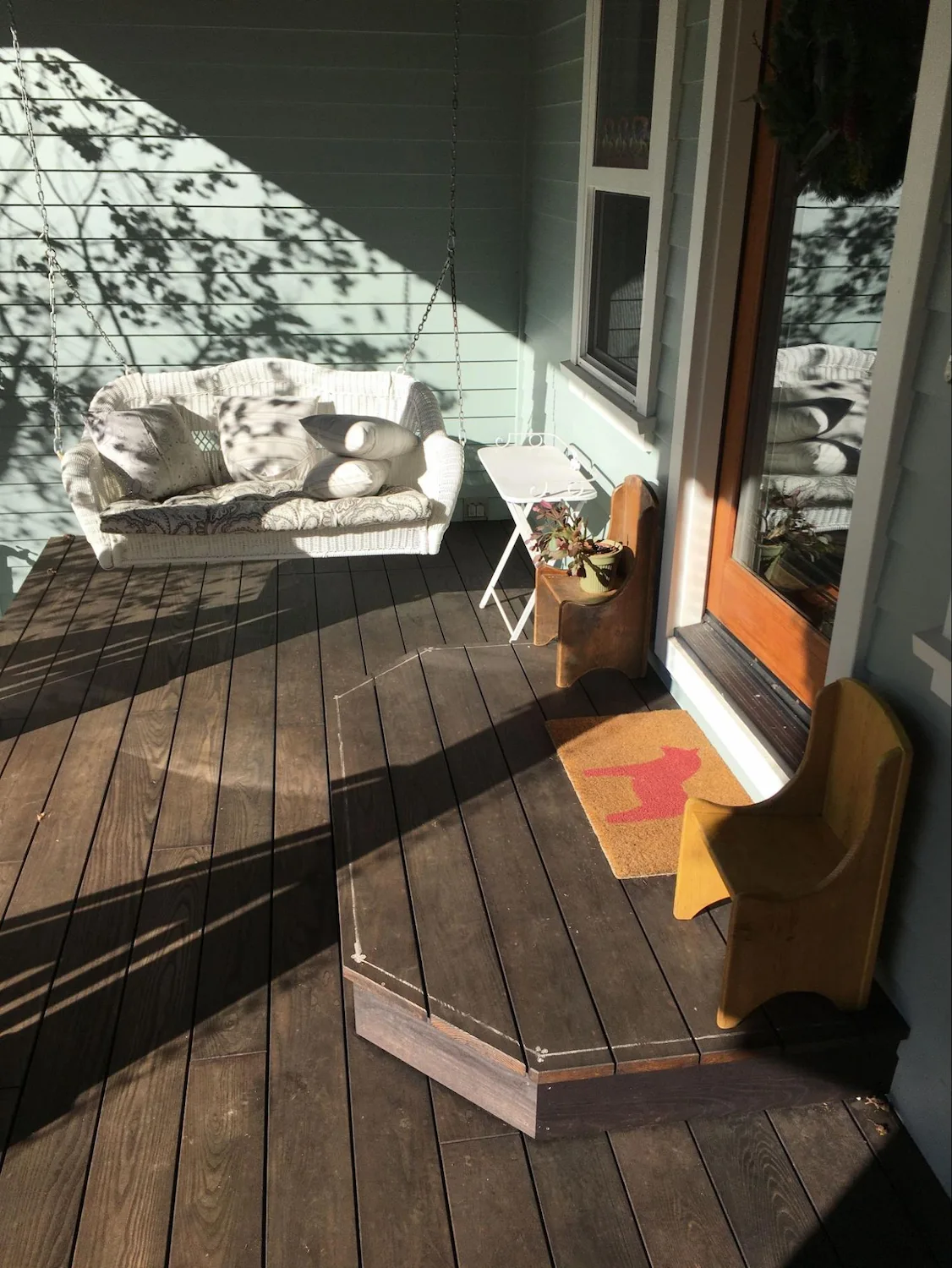 Hardwood patio constructed of ipe wood species. Patios are considered covered decks and share similar wildfire vulnerabilities and mitigations.
Hardwood patio constructed of ipe wood species. Patios are considered covered decks and share similar wildfire vulnerabilities and mitigations.
Composite
Composite decking products are somewhat common and have gained market share in recent years. The two most common products are:
- Polyethylene-based (e.g., Trex, Timbertech, Fiberon)
- Have an approximately even ratio of plastic and wood fibers with a small percentage by weight of additives, including fire retardants
- Polyvinyl chloride-based (PVC) (e.g., Azek)
- Contain no wood fibers nor fire retardants
Composite decking materials have a similar density as hardwoods and are more resistant to ember exposures than softwood deck boards. However, like hardwoods, they will ignite if exposed to enough heat energy for long enough time so as with all decks, it is critical to remove any combustible materials underneath them, including vegetation.
Noncombustible
Noncombustible deck materials have become more popular with modern design trends and as awareness of the dangers decks pose to structures grows. Common noncombustible deck materials include steel and aluminum and come in a variety of textures and finishes, including wood grain. They can be identified by touch, using a handheld magnet (steel only), and looking for repeating grain patterns without knot holes in the case of simulated wood treatments.
To be considered noncombustible for our purposes, all deck materials, including both the deck boards and the structural support system must be made of noncombustible materials. Many decks use timber framing with metal, composite, or lightweight concrete deck board materials, which help reduce risk but are not considered noncombustible.
Noncombustible decks are generally low risk to structures, but it is still important to inspect the area adjacent to structures and ensure the potential for ember accumulation is minimized.
Concrete and masonry decks are considered hardscape ground cover in whichever defensible space zone they occur in and should not be recorded as decks.
Combustible item storage present
Combustible items on or stored underneath decks, patios, and stairs are the greatest vulnerability to attached decks and structures. In a wildfire, embers from vegetation and other structures up to a half mile away contain enough energy to land in and ignite combustible items. Once ignited, flames can spread to the deck and then to the attached structure.
Combustible items covers a wide variety of things that could be stored on or underneath decks, but it comes down to four characteristics: wood, plastic, fuel tanks, or plants. Items made of these materials should never be stored on or underneath decks and should always be removed when red flag warnings are declared or prior to evacuation. Here are some examples of combustible items we’ve seen:
- Wood piles
- Grasses, shrubs, and plant debris
- Lumber and building materials
- Propane tanks (e.g., for grills)
- These are particularly dangerous if ignited because they do not have safety valves and will detonate if heated to a critical failure point, which can shatter windows and propel flaming debris.
- Plastic and wood furniture, including cushions
- Plastic and wood garden sheds
- Door mats and outdoor area rugs
Move combustible items at least five feet away from all structures, including combustible decks. Wood piles and fuel tanks must be at least 30 feet away from all structures.
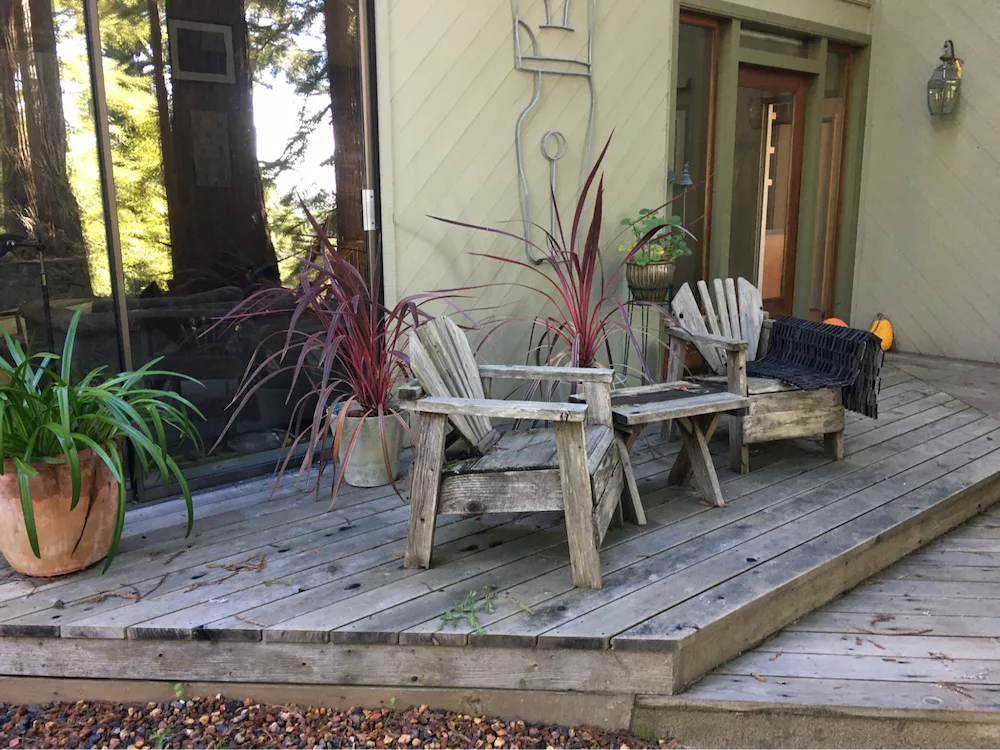 Softwood deck with combustible wood furniture stored. Plants in noncombustible ceramic pots are lower risk but could threaten the sliding glass door if they contained herbaceous or dead/dying plants or bark/wood mulch.
Softwood deck with combustible wood furniture stored. Plants in noncombustible ceramic pots are lower risk but could threaten the sliding glass door if they contained herbaceous or dead/dying plants or bark/wood mulch.
.webp)
Structure-adjacent noncombustible board present
For softwood decks, one of the most cost-effective mitigation strategies is to replace deck boards within 6-12 inches of attached structure with noncombustible deck board(s) or metal grate. These are usually corrosion-resistant steel or aluminum. This has the effect of interrupting the smoldering and flaming ignition pathway that softwood decks are susceptible to.
Implementing this mitigation strategy is easiest where deck boards are parallel to adjacent structures and involves removing the closest one or two deck boards and replacing them with a noncombustible material.
Where deck boards are perpendicular to adjacent structures or interface at an angle, this mitigation option can be more costly because the ends of the deck boards must be sawn, a support truss constructed in the void, and the noncombustible deck boards installed on the newly constructed trusses.
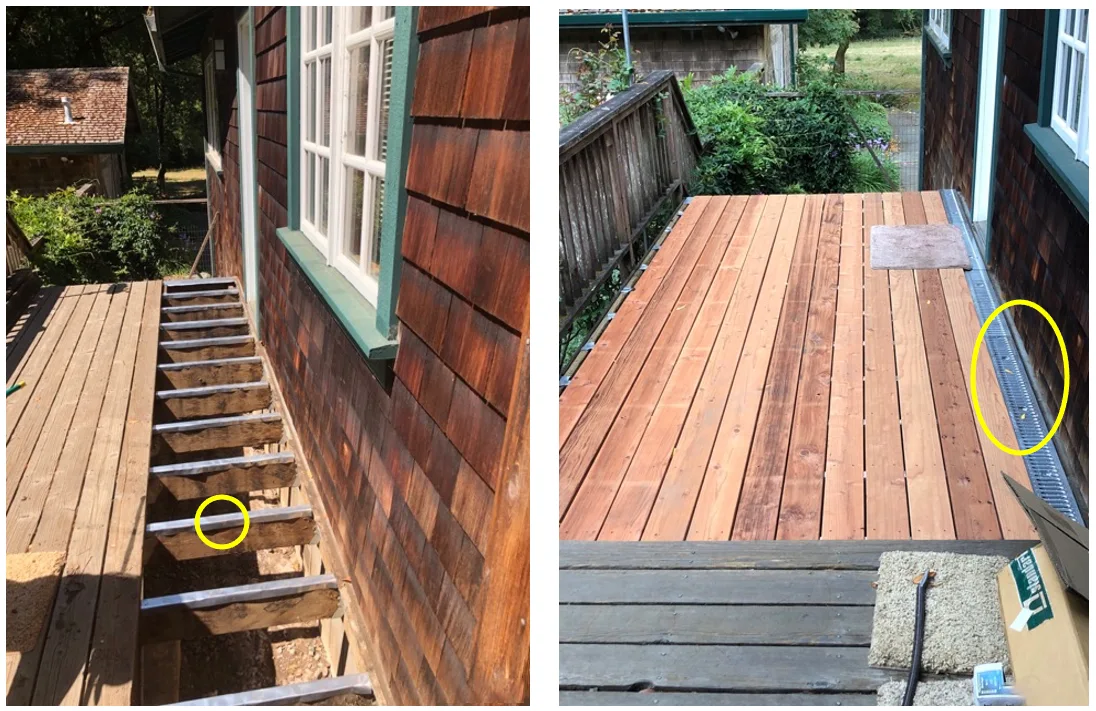 A softwood deck retrofitted with corrosion resistant steel flashing on top of timber joists and a metal grate deck board adjacent to the structure. Foil-faced bitumen tape could be used as an alternative to the flashing on top of the joists.
A softwood deck retrofitted with corrosion resistant steel flashing on top of timber joists and a metal grate deck board adjacent to the structure. Foil-faced bitumen tape could be used as an alternative to the flashing on top of the joists.
Foil-faced bitumen tape present
To mitigate smoldering ember ignitions crawling along joists and igniting an attached structure, installing foil-faced bitumen tape between joists and deck boards can be effective. Remove all the deck boards, apply the tape on top of all joists, and then re-attach the deck boards. This treatment option also improves water shedding and can reduce the potential for dry rot damage.
To identify decks with foil-faced bitumen tape mitigation, inspect the area between deck boards on top of joists and note the presence of metal foil. Ensure that the tape has been applied to the entire length of all joists on a deck in order to be effective.
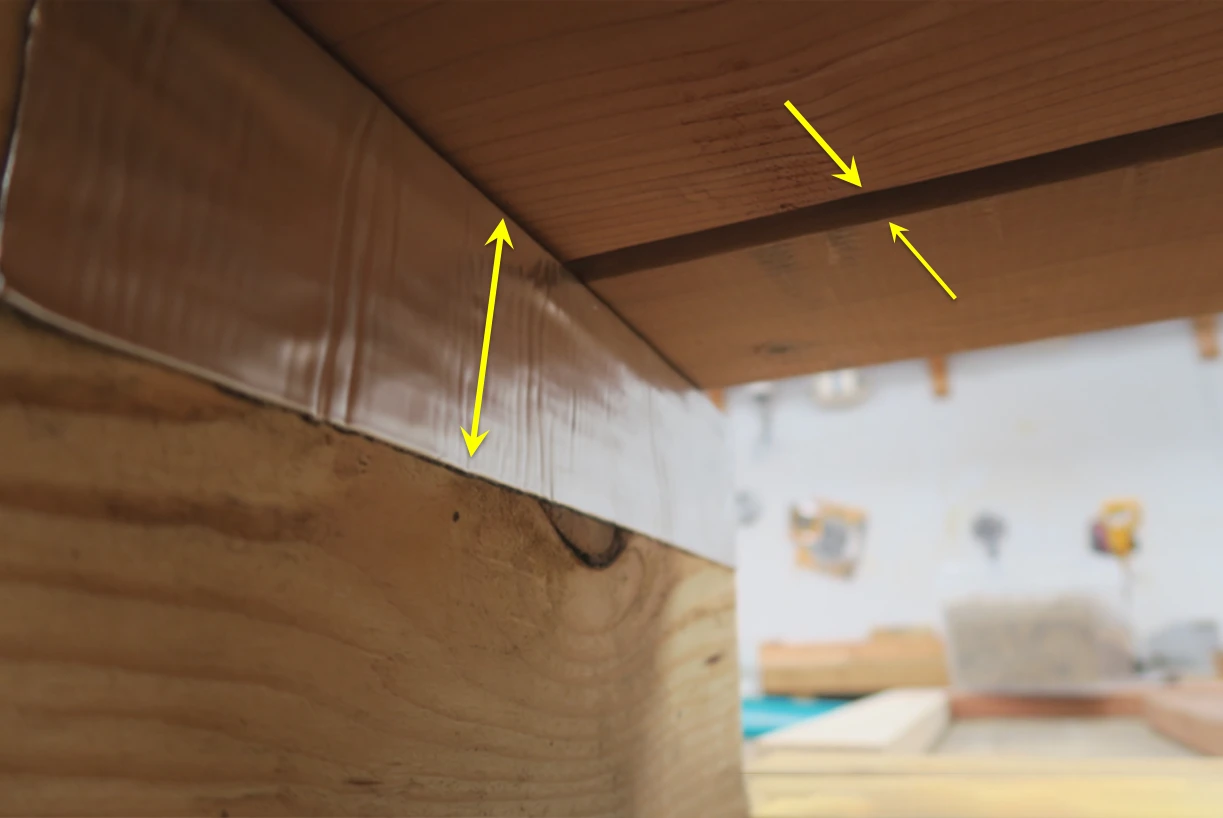 Photo of the underside of a small deck in a test environment. The gap between deck boards is 1/4 inch. Foil-faced bitumen tape is shown applied to the joist.
Photo of the underside of a small deck in a test environment. The gap between deck boards is 1/4 inch. Foil-faced bitumen tape is shown applied to the joist.
Ground clearance
Decks that are less than 24 inches from the bottom of the exterior joist to the ground have different ember mitigation strategies than those with more than 24 inches of clearance above the ground.
Decks with less than 24 inches of clearance can be challenging to mitigate due to restricted access to the area underneath the deck. Plants and debris can often accumulate and be difficult to control.
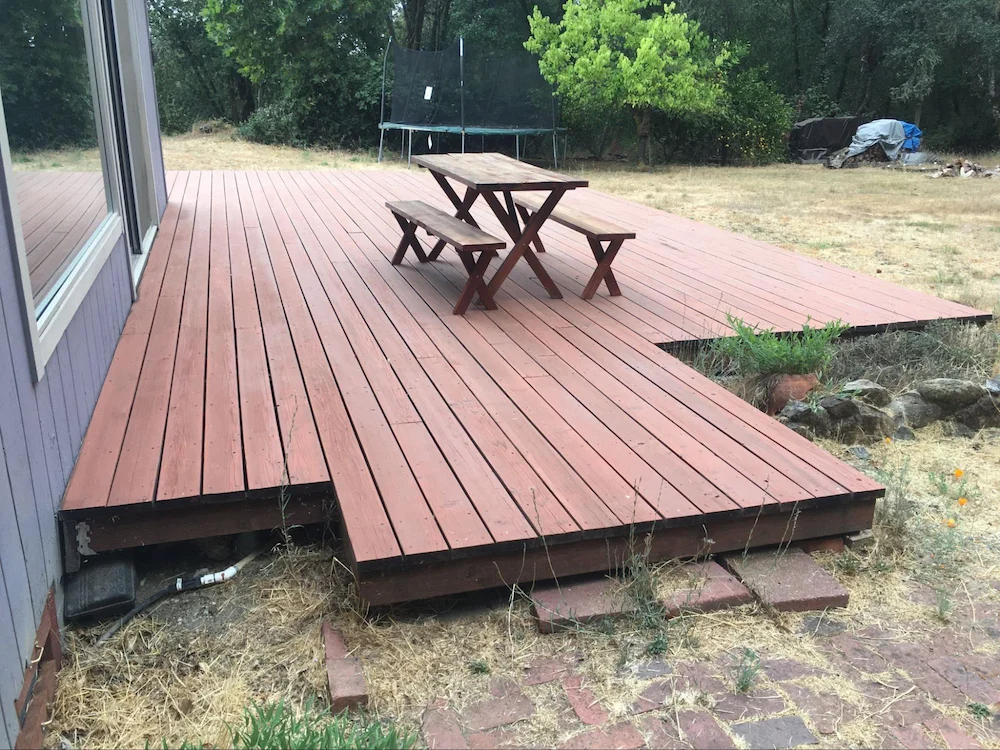 Softwood deck with less than 24 inches of clearance to the ground. These can be challenging to mitigate due to restricted access under the deck, but screening with corrosion-resistant metal mesh mitigates debris accumulation and ember exposure
Softwood deck with less than 24 inches of clearance to the ground. These can be challenging to mitigate due to restricted access under the deck, but screening with corrosion-resistant metal mesh mitigates debris accumulation and ember exposure
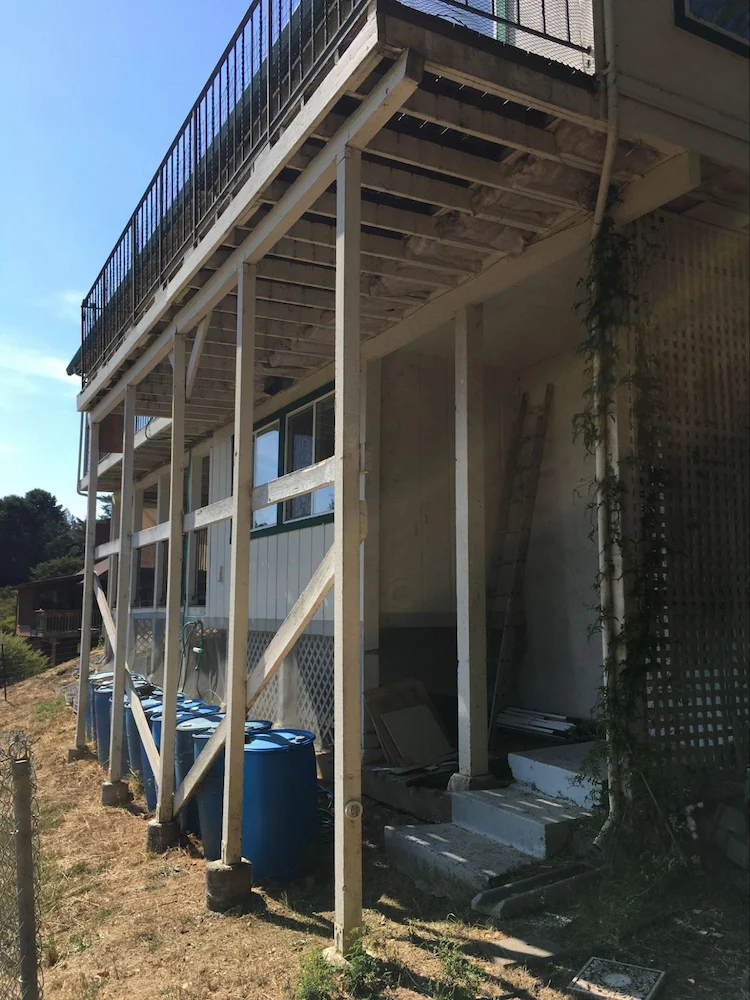 Softwood deck with more than 24 inches of clearance from the ground. Note the mesh screening draped over the gray wooden lattice beyond the deck posts to mitigate ember intrusion into the area underneath the lower portion of the structure. The blue plastic barrels were a recent purchase for a rainwater catchment; however, even if full of water, they are combustible and should not be stored near structures.
Softwood deck with more than 24 inches of clearance from the ground. Note the mesh screening draped over the gray wooden lattice beyond the deck posts to mitigate ember intrusion into the area underneath the lower portion of the structure. The blue plastic barrels were a recent purchase for a rainwater catchment; however, even if full of water, they are combustible and should not be stored near structures.
Screening present
One mitigation for ember exposures to decks is to screen the perimeter with 1/8 inch metal mesh to prevent embers and combustible debris from being blown underneath a deck and igniting the deck from below. Note the presence of metal mesh screening. To be effective, it must be installed around the entire exterior perimeter of the deck (i.e., the sides that are not adjacent to the structure), so if any exterior portion of the deck is unscreened, it should be observed as no screening present.
 Vertical screening enclosure for deck paired with strong noncombustible Zone 0.
Vertical screening enclosure for deck paired with strong noncombustible Zone 0.
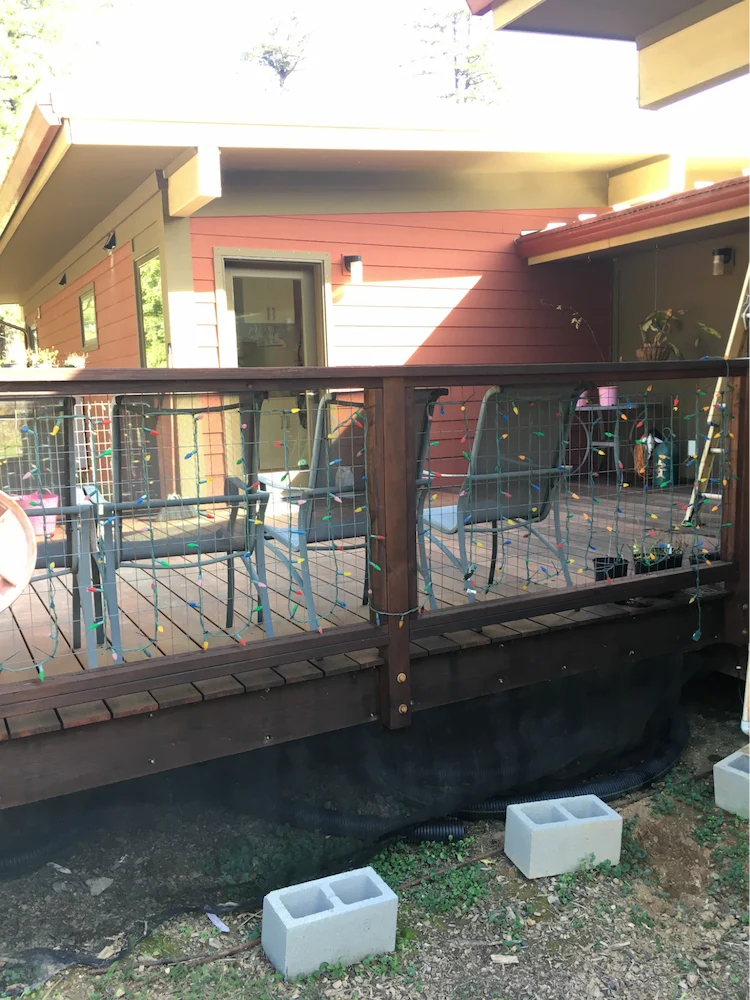 Softwood deck with less than 24 inches of ground clearance and vinyl coated fiberglass mesh screening installed. Note the area on the right where the screening has been pulled back and the combustible plastic hoses stored underneath. This screening example would be ineffective and noncompliant.
Softwood deck with less than 24 inches of ground clearance and vinyl coated fiberglass mesh screening installed. Note the area on the right where the screening has been pulled back and the combustible plastic hoses stored underneath. This screening example would be ineffective and noncompliant.
Installing fascia boards on the exterior vertical surface of the deck can also be effective at blocking debris and embers; however, they must be of a noncombustible material (e.g., fiber cement) or have metal flashing installed over them to mitigate the ember accumulation risks discussed in the siding clearance section.
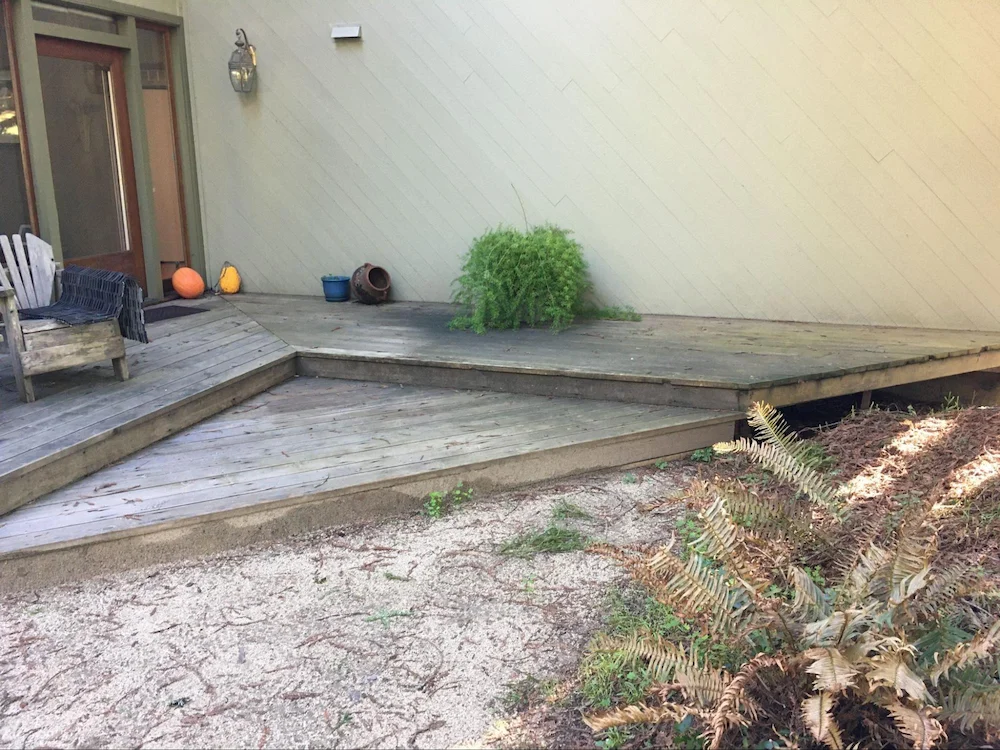 Softwood deck with less than 24 inches of ground clearance and partially enclosed with combustible fascia boards on the exterior perimeter.
Softwood deck with less than 24 inches of ground clearance and partially enclosed with combustible fascia boards on the exterior perimeter.
Screen mesh size
Deck screening should be done with 1/8 inch metal mesh. While 1/16 inch metal mesh is also effective, it is susceptible to debris accumulation and becoming clogged, which can require more frequent maintenance. Meshes larger than a 1/4 inch are not effective at mitigating debris and ember exposures.